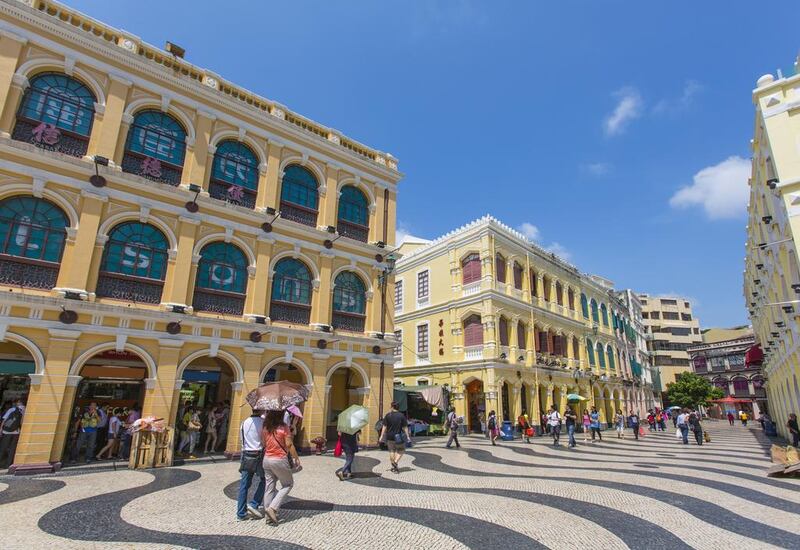Why Macau?
There are two very different faces to this former Portuguese enclave a short boat ride from Hong Kong. There’s the Macau that has been transformed since its return to China in 1999 into the Las Vegas of the East by the construction of giant hotel casinos on a vast land-reclamation project. And there’s my kind of Macau, still a wonderfully exotic destination, where there are reminders everywhere of centuries of Portuguese influence hidden behind the glitzy Vegas facade.
Macau’s ancient colonial and Chinese heritage of churches, mansions, temples and palaces are well protected by Unesco. The food is out of this world, whether you want European fine dining, Cantonese seafood or unique Macanese dishes such as spicy African chicken. And a 10-minute drive can take you from an air-conditioned mall with Cartier and Hermès boutiques to a bracing nature walk through thick forests that rise up above sandy beaches along the South China Sea.
A comfortable bed
The most discrete luxury address is the Mandarin Oriental (www.mandarinoriental.com/macau), one of the rare hotels not to have a casino, while its spa is perfect to relax in after sightseeing or shopping. Double rooms cost from 1,921 Macanese patacas (Dh881).
Nearby is the Metropole (www.metropolehotelmacau.com), a kitsch but comfortable 1970s hotel with reasonable rates. Doubles cost from 692 patacas (Dh317).
At Cotai, the latest plush resort to open is Studio City (www.studiocity-macau.com), offering spacious rooms and suites, plus plenty of entertainment for families travelling with children. Doubles cost from 1,002 patacas (Dh459).
And to get away from it all, in tranquil Coloane, the Pousada de Coloane (www.hotelpcoloane.com.mo) is a traditional, blue-tiled Portuguese inn, near the beach and golf course. Doubles cost from 750 patacas (Dh344).
Find your feet
Begin with a relaxed morning walking tour of the Unesco World Heritage Sites dotted around the ancient streets of Macau’s old town centre. Most tourists just want to snap a selfie against the dramatic ruined facade of the iconic 17th-century St Paul’s Church. But there are more than 20 distinctive pastel monuments of Macau’s colourful history, and not to be missed are the palatial Chinese Mandarin Mansion, the imposing mid-16th-century baroque St Lawrence’s Church and the Senate building, with an immense square that serves as the unofficial town centre. There’s also Taipa, a quaint village of boutiques and restaurants, while unspoilt Coloane offers quiet beaches and surprising nature trails.
Meet the locals
A minute’s walk from the huge crowds that gather around St Paul’s Church, Calcada do Amparo, better known as Portuguese Street, is a haven of peace where Macanese meet in friendly coffee shops, go shopping for antiques and snack on street food.
Out in Taipa, Quarter Square (Largo Maia de Magalhaes) is a popular barista coffee bar and design showroom, while Art Space (Rua dos Clerigos) is a new gallery and meeting place for photographers and artists.
Book a table
Macau is a cosmopolitan foodie paradise. The one address everyone wants to be seen at is Robuchon au Dôme (www.grandlisboahotel.com), a glamorous golden cage atop the Grand Lisboa casino. Joel Robuchon proposes his classic French cuisine with an Asian twist, such as roast lobster with green peas and bok choy. Reservations are a must. Expect to pay 2,988 patacas (Dh1,410) for the eight-course tasting menu.
For exquisite Chinese recipes that blend Asian herbs and vegetables with lobster, abalone, chicken and lamb, visit the two-Michelin-star Jade Dragon (www.cityofdreamsmacau.com) an elegant dining room hidden between the noisy gaming rooms of City of Dreams.
For a completely different experience, visit Taipa at night, where half a dozen Portuguese taverns are tucked away in the side streets. At António (www.antoniomacau.com) diners are serenaded by musicians and enchanted by genial chef António Coelho, with a menu that's a feast of traditional dishes such as bacalhau cozido – cod with chickpeas and egg – for 270 patacas (Dh124) and atum fresco – barbecued tuna with a rich red-onion sauce – for 290 patacas (Dh133).
Shopper’s paradise
Every designer brand in the world seems to be on show at mega malls such as The Shoppes at Four Seasons or One Central Macau. But it’s much more fun to explore the backstreets of the old town and discover original boutiques, such as Iaohin Gallery (Rua de Tercena), which makes intricate amber jewellery, or Macau Fashion Gallery (Rue de São Roque), which showcases young Macanese fashion designers. Then there are dozens of Koi Kei bakeries everywhere, where visitors buy the irresistible almond cookies.
Don’t miss
The 500-year-old Santa Casa de Misericórdia Albergue, which has been transformed into a vibrant centre for art, music and street festivals.
What to avoid
The Giant Panda Pavilion. Everyone wants the chance to see one of the iconic animals, but there are long queues and most of the time, they’re asleep anyway.
Getting there
Emirates (www.emirates.com) flies from Dubai to Hong Kong daily from Dh2,990. From there, a high-speed ferry (www.turbojet.com.hk) costs 317 patacas (Dh145) return.










